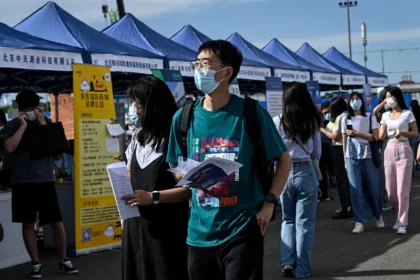U.S. President Donald Trump is rejecting claims that his 90-day tariff delay is allowing countries to avoid trade penalties. In a firm statement on Sunday, Trump emphasized that all nations, particularly China, are still under significant pressure and facing severe consequences from the U.S. trade policies.
Uncertainty in Global Markets Following April Tariff Announcements
Following President Trump’s announcement of sweeping tariffs on April 2, global markets have been grappling with uncertainty. A brief pause in the most severe tariffs allowed a temporary market recovery. However, most countries now face a 10% levy, while China has taken a more aggressive stance, escalating its own tariffs to 125%. As a result, U.S. tariffs on Chinese goods have reached a staggering 145%.
Trump Remains Committed to Correcting Trade Imbalances
Despite the temporary reprieve, Trump remains committed to addressing what he describes as unfair trade imbalances. “NOBODY is getting ‘off the hook’ for the unfair Trade Balances, and Non-Monetary Tariff Barriers that other Countries have used against us, especially not China, which, by far, treats us the worst!” he posted on Truth Social, reiterating his position on trade fairness.
Exemptions for Chinese Electronics: Temporary or Long-Term?
Trump’s administration granted a temporary exemption on Friday for certain Chinese electronics and semiconductors. However, the president clarified on Sunday that this exemption does not represent a full break from tariffs. “No Tariff ‘exception’” was made, he explained, with affected products still facing a 20% tariff under a separate category.
Future Tariff Plans: Targeting Semiconductors and Pharmaceuticals
In the coming months, Trump’s administration plans to implement additional targeted tariffs, particularly aimed at semiconductors and pharmaceuticals. These sectors fall outside of the reciprocal tariff structure, and Commerce Secretary Howard Lutnick has emphasized that these measures are aimed at protecting U.S. economic interests. Trump is expected to make “very specific” announcements on Monday about which products will be next in line for tariffs.
Short-Term Exemptions for Consumer Electronics
Although certain exemptions have been granted, these are not expected to last. Consumer electronics, in particular, could soon face additional tariffs as part of a broader strategy to protect U.S. national security. This approach reflects the administration’s continued focus on safeguarding U.S. industries and reducing reliance on foreign imports.
China Looks Elsewhere: Xi Jinping’s Southeast Asia Visit
While President Trump maintains a firm stance on tariffs, China is focusing its efforts elsewhere. On Monday, President Xi Jinping will begin a five-day visit to Southeast Asia, where he aims to strengthen economic ties with countries like Vietnam and Malaysia. This outreach comes as China looks to diversify its economic partnerships in light of escalating tensions with the U.S.
White House Claims Success Amid Wall Street Pushback
Despite pushback from Wall Street and ongoing market instability, the White House remains confident in its tariff strategy. The administration insists that the tariff approach is already prompting several countries to seek new trade deals before the 90-day window ends. This shift in global trade dynamics signals the potential long-term impact of President Trump’s economic policies.
Conclusion: The Future of U.S.-China Trade Relations
As President Trump holds firm on his trade policies, China’s aggressive response and its efforts to forge new economic alliances highlight the evolving landscape of global trade. With new tariffs on the horizon and continuing negotiations, the U.S. and China are locked in a battle that will shape the future of international trade relations.




